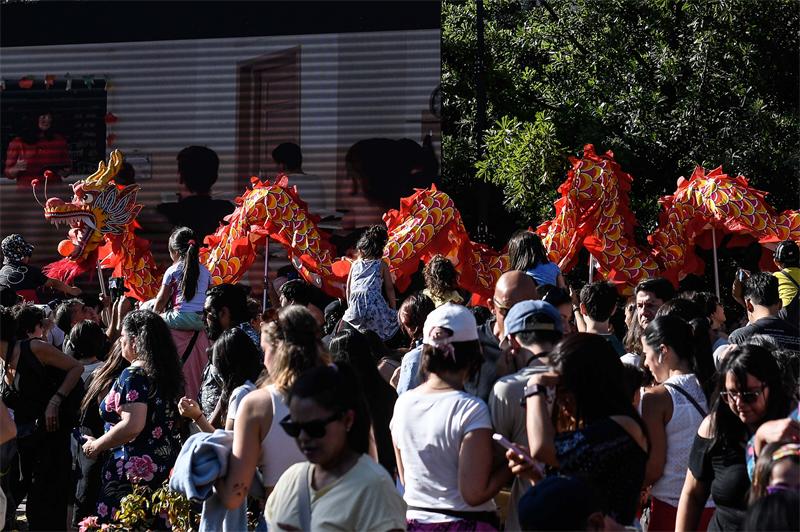China's consumption recovery in 2023 to bring benefits to world

People visit Yuyuan Garden in east China's Shanghai, Feb. 3, 2023. (Xinhua/Liu Ying)
China's consumption posted a strong recovery during the Spring Festival holiday with sectors such as catering, tourism, and recreation performing impressively, signalling a good start to the year's economic growth.
The burgeoning consumption has demonstrated the strong resilience and vitality of the Chinese economy. Countries and regions around the globe are expecting the warming Chinese economy to bring more benefits to the world.
In 2023, Chinese central and local governments will give priority to the expansion of consumption by implementing a string of stimulus policies.
-- Consumption recovery
During the Spring Festival holiday, the first long holiday after China adjusted COVID-19 response measures, the country's consumer service sectors, including catering, tourism and shopping saw a strong rebound in demand.
Sales revenue of China's consumption-related sectors during the week-long holiday rose 12.2 percent from the same holiday period in 2022, according to the State Taxation Administration.
Data from the Ministry of Commerce (MOC) showed that the combined revenue of major retail and catering businesses went up 6.8 percent year on year during the holiday.
Tourism consumption also heated up. In the past week, the number of ticket orders on China's e-commerce platform Meituan for tourist attractions in Xishuangbanna, southwest China's Yunnan Province surged 408 percent year on year, and that for scenic spots in Chongzuo, south China's Guangxi Zhuang Autonomous Region skyrocketed over 2,000 percent year on year.
Offline consumption was galvanized by more visits to mortar stores. For example, in the first four days of the holiday, about 14.13 million visits were made to Beijing's 60 major shopping centers, creating 2.84 billion yuan of sales income for main department stores, supermarkets, restaurants, e-commerce enterprises, etc., up 13.7 percent from the pre-pandemic level in 2019, according to data from Beijing Municipal Commerce Bureau.
People's desire for a better life is the strongest motivation to consume more. During the holiday, the trend of diversified, personalized and health-centered consumption became salient, mirrored by the popularity of experience-based consumption like wakesurfing, night tour for lantern appreciation, outdoor camping, and the pursuit for heathcare-related products and green consumption.
Government support is another factor driving consumption growth. Since the Spring Festival, governments of cities including Hangzhou, Jinan and Yantai have issued consumption vouchers to citizens, encouraging them to spend on various sectors such as clothing, dining, housing, transportation, travel, shopping and recreation.
-- Driving global economic growth
The booming consumption during the Spring Festival holiday has shown the strong resilience and vitality of the Chinese economy. It is widely expected that the Chinese economy will continue bringing benefits to the world as it maintains strong growth momentum this year.

People watch a dragon dance performance during an event celebrating the Chinese New Year in Santiago, Chile, Jan. 14, 2023. (Photo by Jorge Villegas/Xinhua)
In the international trade area, global trading partners are optimistic about the prospects of the Chinese market.
Chilean cherries became one of the fashionable fruits shared in Chinese New Year celebrations, Chilean agriculture magazine MundoAgro reported on January 25 quoting Claudia Soler, manager of the cherries committee of the Association of Chilean Fruit Exporters. According to Claudia Soler, market expectation of Chilean cherry exports to China is very optimistic this year as demand grows strongly in the country's second- and third-tier cities.
South American fruits, wine, beef and other high-quality agricultural products are well received in the Chinese market. More export opportunities will come in the year of 2023, reported Argentine business newspaper El Cronista.
In the field of auto consumption, Puneet Gupta, head of the India/ASEAN automotive sales forecasting team of S&P Global Mobility, said that China is a big consumer market and pent-up demand will further add excitement to related businesses. New investments will be made in China, and manufacturing will rebound like never before in 2023.
Looking at tourism sector, an increasing number of Chinese tourists are found to travel abroad, injecting new impetus to global tourism industry.
China's COVID-19 response shift increases the likelihood of a swift recovery of tourism sector in the Asia-Pacific region, with Thailand and Malaysia likely to benefit the most. Chinese tourists could also provide varying degrees of support to the macroeconomic performance of Singapore, Vietnam and Sri Lanka, according to a report released by Fitch Ratings last month.
In an update to its World Economic Outlook report released in late January, the International Monetary Fund (IMF) projected China's economy, driven by a rebound in private consumption, will grow by 5.2 percent in 2023, 0.8 percentage point higher than the October 2022 forecast. The IMF expected that with China's economy now reopening, China and India would account for half of global growth this year.
-- Increasing policy incentives
In 2023, Chinese central and local governments will give priority to the expansion of consumption with stimulus policies.
The Central Economic Work Conference, which was held at the end of last year, stated that priority should be given to restoring and expanding consumption in 2023.
Timely measures will be taken to promote an early recovery of consumption as the main economic driving force, according to the State Council executive meeting held on January 28.
The MOC pledged efforts to stimulate consumption this year, with focus on stabilizing and expanding auto sales.
At local level, governments have put promoting consumption high on their agenda in this year's budget plans.
For instance, east China's Fujian Province proposed to boost consumption of intelligent offerings and auto sales.
Central China's Hunan Province put forward to optimize income distribution structure in a bid to enhance residents' consumption capacity and guide spending on housing improvement, new energy vehicles (NEVs) and elderly care services.
South China's Guangdong Province made it clear to arrange 322 million yuan of funds to support construction of consumption hubs and catering brand upgrading, as well as improve construction of county business systems. It will also earmark 1.845 billion yuan to promote use of NEVs and accelerate construction of charging facilities.
With economy back on normal track, coupled with greater policy support for poverty alleviation and rural revitalization, China's consumption is expected to maintain an average annual growth rate of about 5 percent in the next few years, according to Tian Yun, former director of the information department of China Society of Macroeconomics under the National Development and Reform Commission.


